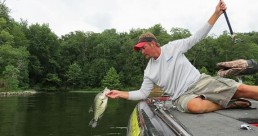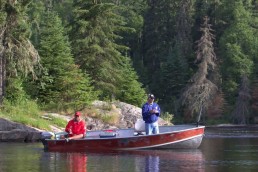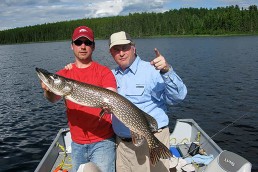Black Crappie Summer Patterns on Kinkaid Lake
Although our quarry of choice today is the black crappie, the discussion soon turns to the four types of crappies here in southern Illinois on Kinkaid Lake. The lake is about an hour drive south of East St. Louis.
As we pull out of the cove concealing Paul Ice Boat Ramp, Kyle explains that the really large “black crappies” of the lake are actually hybrids. The other species in the lake are blacknose crappies, black crappies and white crappies.
Kyle Schoenherr is a professional crappie angler and local guide. He has consulted with biologists about the hybrids and all seem to agree with his assessment of the genealogy of these big fish.
The hybrid fish resemble the white crappie generally except they have seven or eight spines in the dorsal fin and their color is reminiscent of the black crappie. White crappies have six spines. The hybrids have the speckled pattern on the sides but also have vertical bars that the whites do not display.
The fish grow quickly and have some of the habits of both the white and black crappie. They appear to be a naturally produced hybrid and not one introduced to the lake.
An internet search finds that the first hybrids came from Arkansas where they were the offspring of Blacknose crappies and true white crappies. Kinkaid has two populations of introduced Blacknose crappies. One was introduced in September of 2010 and the other in August of 2012.
The literature maintains that hybrids appear naturally but are not common. They have the physical appearance of one species and the spine count of the other. The biggest crappies seem to be the hybrids. The second-generation fish will reproduce, but do not grow fast, and are highly susceptible to predation from largemouth bass and bluegills. The first-generation fish grow faster and weigh more than either the black crappie or white crappie.
Hybrid or natural black crappie, we are seeking them on a summer pattern developed by Kyle. Up to this point in the year, the white and black crappies exhibit similar feeding patterns. As the water heats up and there is more sunlight, the fish go deep and into vegetation or other shady areas.
In summer, the black crappies prefer main lake points following the spring spawn. They are building up their food stores. Kyle seeks out main lake points that are near the vegetation. The predominant vegetation he finds is milfoil in clear water.
Here in Kinkaid Lake, the vegetation is in water that is less than 15-feet deep, spread over wide areas of the lake. The shad seem to be favorite forage for the white crappies. Anglers suspend them beneath a slip float on a jig.
We are fishing today with the jigs suspended about 6 feet down. The key is to locate fish on the edge of structure and determine their depth. The slip float permits you holding the lure at that depth or a little above it.
Black and hybrid black crappies both feed like bluegills. Blacks also feed on bluegill minnows. They will take small jigs with a minnow attached, but they also relish taking waxworms. The waxworm bite seems to be one of aggression. This may be in response to being so protective of their territory, nests and minnows.
Kyle usually fishes with a plastic grub on a small jig. If the bite is slow or turns off, he will remove the skirt from a Road Runner and replace it with three waxworms. Impale the waxworms on the hook by one end so they are free to wiggle and attract a bite.
Using a long jigging pole with light monofilament line, impart action to the bait by a slight jigging motion. Once the float disappears or tips over, immediately lift it straight up. This aids in the hook set and also helps to avoid the heavy vegetation into which the fish is likely to go.
Don Gasaway is a veteran outdoor writer from Marion, Ill. He may be contacted at: dongasaway.wordpress.com or facebook.com/DonsJournal (you must be logged into facebook in order to view this page).
MWO
SHARE THIS POST
You may also like...
Did you enjoy this post?
You can be among the first to get the latest info on where to go, what to use and how to use it!
Don Gasaway
Don Gasaway is a veteran freelance outdoor writer from Marion, Ill. He may also be found at: https://www.facebook.com/DonGasawayWriter and facebook.com/Wandering Angler. Comments are welcome



